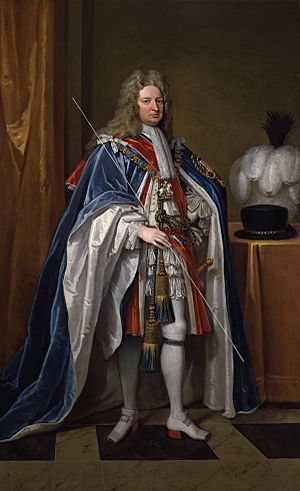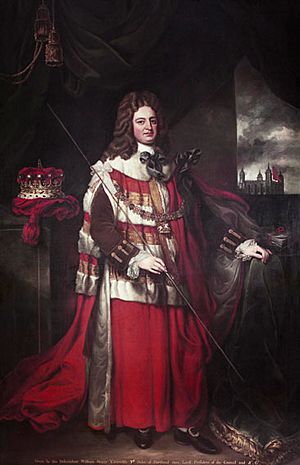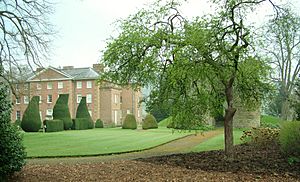Robert Harley, 1st Earl of Oxford and Earl Mortimer facts for kids
Quick facts for kids
The Earl of Oxford and Earl Mortimer
|
|
|---|---|

Portrait by Godfrey Kneller, 1714
|
|
| Chief Minister of Great Britain Lord High Treasurer |
|
| In office 30 May 1711 – 30 July 1714 |
|
| Monarch | Anne |
| Preceded by | Commission of the Treasury |
| Succeeded by | The Duke of Shrewsbury |
| Chancellor of the Exchequer | |
| In office 11 August 1710 – 4 June 1711 |
|
| Monarch | Anne |
| Preceded by | John Smith |
| Succeeded by | Robert Benson |
| Secretary of State for the Northern Department | |
| In office 18 May 1704 – 13 February 1708 |
|
| Monarch | Anne |
| Preceded by | Sir Charles Hedges |
| Succeeded by | Henry Boyle |
| Speaker of the House of Commons | |
| In office February 1701 – 25 October 1705 |
|
| Monarch | William III Anne |
| Preceded by | Sir Thomas Littleton |
| Succeeded by | John Smith |
| Personal details | |
| Born | 5 December 1661 Covent Garden, Middlesex, Kingdom of England |
| Died | 21 May 1724 (aged 62) Westminster, Middlesex, England, Kingdom of Great Britain |
| Resting place | Brampton Bryan, Herefordshire |
| Political party | Country |
| Spouses | Elizabeth Foley Sarah Middleton |
| Children | 4, including Edward |
| Parents | Sir Edward Harley Abigail Stephens |
Robert Harley, 1st Earl of Oxford and Earl Mortimer (born December 5, 1661 – died May 21, 1724) was an important English politician. He lived during the late Stuart and early Georgian periods. He started his career with the Whig political group. Later, he joined a new Tory government.
In 1711, he was given the title of earl. From 1711 to 1714, he served as Lord High Treasurer. This made him Queen Anne's main minister. Some people call him a prime minister. However, the first person truly seen as a prime minister was Robert Walpole in 1721.
A major success of Harley's time in government was the Treaty of Utrecht in 1713. This agreement with France ended the War of the Spanish Succession, which had lasted twelve years. In 1714, Harley lost his power when George I became king. His political rivals even put him in the Tower of London for a while.
Harley was also known for his love of books and writing. He supported writers like Jonathan Swift. Harley Street in London is sometimes thought to be named after him. But it was actually his son, Edward Harley, who developed that area.
Contents
- Robert Harley's Early Life (1661–1688)
- The Glorious Revolution (1688–1689)
- Becoming a Member of Parliament (1689–1701)
- Speaker of the House of Commons (1701–1705)
- Northern Secretary (1704–1708)
- In Opposition (1708–1710)
- Chancellor of the Exchequer (1710–1711)
- Lord High Treasurer (1711–1714)
- Imprisonment (1715–1717)
- Later Life (1717–1724)
- Literary Importance
- Family Life
- Images for kids
- See also
Robert Harley's Early Life (1661–1688)
Harley was born in London in 1661. He was the oldest son of Sir Edward Harley. His father was a well-known landowner in Herefordshire. Robert's mother was Abigail Stephens.
He went to a small school near Burford in Oxfordshire. This school was famous for educating future leaders. It produced a Lord High Treasurer (Harley), a Lord High Chancellor, and a Lord Chief Justice. Harley later studied law but never became a lawyer.
He learned about Whiggism and Nonconformism (a type of Protestantism) from a young age. He kept his family's religious beliefs, even when his political views changed.
The Glorious Revolution (1688–1689)
In 1688, Harley helped his father support William, Prince of Orange. They were against the policies of King James II. When William arrived in England, Harley and his father quickly gathered a group of soldiers. They took control of the city of Worcester for William.
Harley then went to meet William to report their success. He was given a role as a major in the local army in Herefordshire. He held this position for several years.
Becoming a Member of Parliament (1689–1701)
Because of his actions, Robert Harley was noticed by important families. In 1689, he was elected to Parliament for Tregony. He also served as High Sheriff of Herefordshire. After one term, he was elected for New Radnor in 1690. He represented this area until he became an earl in 1711.
Harley paid close attention to how Parliament worked. He studied the rules and traditions of the House of Commons.
He supported the Toleration Bill. This bill aimed to allow more religious freedom. He also helped stop a change to the Bill of Rights. This change would have allowed King James II's son to become king if he became Protestant.
In 1692, Harley suggested that English army regiments should be led by Englishmen. This was after French victories in Flanders. The House of Commons agreed with his idea.
During the 1690s, Harley became a leader of the 'Old Whigs'. These Whigs worked with Tories against the ruling 'court Whigs'. He also joined a group to check how the government was spending money.
Harley wanted to limit the power of the king to give out government jobs. He believed this would make Parliament stronger. He also supported the Triennial Bill. This bill would limit how long a Parliament could last to three years. He argued that shorter parliaments represented the people better.
In 1698, Harley became a leader of the combined Whig-Tory opposition. He also started working with Sidney Godolphin, 1st Earl of Godolphin. This led to him joining the circle around Princess Anne.
Harley was offered government jobs in 1698 and 1700. But he refused because he did not want to work with the Whigs. After Princess Anne's only child died, King William III worried about who would be next in line to the throne. He wanted the crown to go to Sophia, Electress of Hanover. William met with Harley to discuss what Parliament would need to agree to this. They decided to add more limits to the monarch's power. After this, William approved Harley's election as Speaker.
Speaker of the House of Commons (1701–1705)
After the election in February 1701, Harley served as Speaker for three Parliaments. He held this role until March 1705. From May 18, 1704, he also became the Secretary of State for the Northern Department.
As Speaker, Harley helped pass the Act of Settlement 1701. This act set the new line of succession to the throne. Harley was happy that both Whigs and Tories agreed to limit the crown's power. He hoped that political divisions would disappear.
Northern Secretary (1704–1708)
Harley was very good at managing public opinion. In 1703, he hired Daniel Defoe to write political articles. Later, he also hired Delarivier Manley and Jonathan Swift to write pamphlets against his political opponents.
During his time as Secretary, the Act of Union 1707 with Scotland was created. Harley had shown no signs of being unhappy with the Whigs when he became Secretary of State. He got the job mainly because of Marlborough's influence.
For a while, Harley worked well with his colleagues. But in 1707, it became clear that someone was secretly influencing the Queen. The Queen felt that the safety of the Church of England depended on the Tories. These ideas were strengthened by her new favorite, Abigail Masham. Abigail was a cousin of both the Duchess of Marlborough and Harley. The Queen liked Abigail's gentle manner more than the Duchess of Marlborough's proud ways.
The Duchess and Sidney Godolphin, 1st Earl of Godolphin believed Harley was behind this change in the Queen's feelings. However, Harley was allowed to keep his job. Later, a clerk in Harley's office, William Gregg, was found giving secret documents to the French. It turned out that Harley's office had very loose security. Daniel Defoe had even warned Harley about this.
Godolphin and Marlborough told the Queen they would not work with Harley anymore. They did not attend the next council meeting. The Queen was forced to accept Harley's resignation on February 11, 1708.
In Opposition (1708–1710)
Harley lost his job, but his cousin Abigail stayed in the Queen's service. Harley used her influence to his advantage. He used the high cost of the war with France and the danger to the national church to gain public support.
Marlborough himself could not be removed, but his relatives were dismissed. When Lord Godolphin was removed from office in August 1710, Harley was appointed Chancellor of the Exchequer.
Chancellor of the Exchequer (1710–1711)
Harley wanted to create a government with moderate members from both parties. He also planned to keep most of his predecessors' policies. But his plans did not work out. The Whigs refused to join him. The Tories, who had won many seats in the election, wanted their leaders to adopt policies more favorable to their party.

Then, something unexpected happened that made Harley popular again. A French refugee, the Marquis de Guiscard, attacked Harley with a penknife during a meeting on March 8, 1711. Luckily, Harley was wearing a fancy gold waistcoat, which stopped the knife. It's still a mystery why Guiscard had a weapon. But Harley was known for being careless about security.
The wounds were not serious for a healthy person. However, Harley had been ill. The country was very happy when he recovered. Both houses of Parliament sent messages to the Queen. The Speaker of the House of Commons gave a speech praising Harley.
One big problem at this time was the country's finances. The war with France was very expensive. In 1711, Harley created the South Sea Company to help manage the national debt. This company was very successful at first. He managed to restore confidence in the country's finances.
Lord High Treasurer (1711–1714)
On May 23, 1711, Harley became Baron Harley and Earl of Oxford and Earl Mortimer. He chose the title Oxford because of his family's connection to previous holders of that title. On May 29, he was appointed Lord Treasurer. On October 25, 1712, he became a Knight of the Garter.
There was another attempt on his life in November. This was called the Bandbox Plot. A hat-box with loaded pistols was sent to him. But Jonathan Swift discovered it and stopped the assassination.
With public sympathy from these attacks, Harley managed to stay in office. He reorganized the nation's money. He continued to provide resources for the army. At the same time, he was secretly talking with the French King about peace terms. After many discussions, the preliminary peace was signed. Despite opposition in the House of Lords, the Treaty of Utrecht was finalized on March 31, 1713. To pass the treaty, twelve new peers were created, nicknamed Harley's Dozen.

While these talks were happening, the friendship between Harley (now Oxford) and St John turned into hatred. St John felt jealous of Harley's success. When St John became a Viscount instead of an Earl, he was very angry. The Queen's favorite, Abigail, also sided with St John.
The Jacobites (supporters of James II's son) found that Harley made many promises but did not act. They stopped trusting him. Even Harley's friends complained that he was too slow. They blamed his poor health and sadness over losing his child. Queen Anne slowly trusted Bolingbroke more than Oxford. On July 27, 1714, Harley resigned as Lord Treasurer. The Queen died on August 1.
Imprisonment (1715–1717)
When George I of Great Britain became king, Harley retired. But a few months later, he was accused of serious wrongdoing. He was sent to the Tower of London on July 16, 1715. He was accused of high treason and other serious crimes. The punishment for treason could be death. Many of the accusations were about his role in the Treaty of Utrecht. He was also accused of secretly plotting with the Jacobite claimant James. His political friends, St John and Ormonde, fled to France to avoid arrest.
Harley was in poor health at first. His wife, Sarah, stayed with him in prison. A major rebellion happened soon after he was arrested. Investigators tried to link Harley to the rebellion, but they found no evidence. This delayed his trial, which may have helped him. By 1717, the anger against him had calmed down.
Harley also benefited from a split among the Whigs. This made it easier for him to be released. After almost two years, Harley was officially cleared of the charges. He was allowed to return to his place among the peers.
Later Life (1717–1724)
After his release, George I told Oxford he was not welcome at court. He joined other Tory lords to oppose the new Whig government in Parliament. In 1719, they worked together to defeat the Peerage Bill. After this, Lord Oxford took less part in public life. He died in London on May 21, 1724.
Literary Importance
Harley was very important to literature. He was a great supporter of the arts. He also helped preserve old writings. He used his wealth to build an amazing library. He ordered collections of old songs and bought many poems. He saved literature from the Renaissance, Anglo-Saxon writings, and much Middle English literature.
His collection, along with his son's, was sold to Parliament in 1753. It became part of the British Museum and is known as the Harley Collection.
When he was in government, Harley helped the careers of writers like Jonathan Swift, Alexander Pope, and John Gay. He also wrote with them as a member of the Scriblerus Club. He contributed to the Club's writings. He was especially good at poetry. Some of his unsigned poems have been saved. He also likely helped write The Memoirs of Martinus Scriblerus.
Historian David C. Douglas said that scholars looked up to Robert Harley. He was seen as a great supporter of English medieval learning. He helped many scholars and deserved their thanks. His book collecting also earned him the gratitude of future generations.
Family Life
In May 1685, Harley married Elizabeth Foley. They had four children before she died in 1691:
- Abigail (born around 1685 – died July 15, 1750), who married George Hay in 1709.
- Edward (born June 2, 1689 – died June 16, 1741). He married Henrietta Cavendish Holles and became the 2nd Earl.
- Elizabeth (born June 2, 1689 – died November 20, 1713), who married Peregrine Osborne in 1712.
- Robert, who died as a baby in 1690.
They lived at Brampton Bryan Hall, which Harley inherited in 1700.
After Elizabeth's death, Harley married Sarah Middleton in 1694. They did not have any children. He died in 1724 in London and was buried in Brampton Bryan, Herefordshire.
Images for kids
-
Oxford (right), with his friend and ally Henry St John, 1st Viscount Bolingbroke and a portrait of Francis Atterbury. Engraving after a painting by Sir Godfrey Kneller.
-
Robert Harley pictured carrying the white staff of the Lord High Treasurer. Portrait by Jonathan Richardson.
See also
 In Spanish: Robert Harley para niños
In Spanish: Robert Harley para niños







